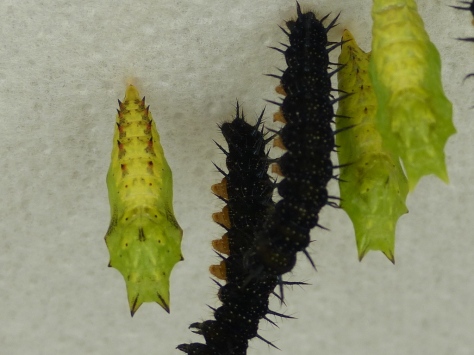My caterpillars have been entertaining me today.
They were very well behaved when the time came to pupate. For the last week they have been escaping and running all around my kitchen and causing me no end of problems. I was dreading the time when they decided to leave the host plant and pupate but they were all very good and stayed in their cupboard. They made life very easy for me.
This video runs for six minutes because that is how long it takes the caterpillar to shed it’s skin and then attach itself to the roof of the cupboard. I don’t expect people to watch a six minute video, just watch what you like but it is important that we have it.
I will just tell you what you are going to see. The caterpillar has attached a ball of silk to the roof and he is hanging from his two back prolegs. His skin will split and inside there is a chrysalis. There is a moment when the old skin has almost been shed when the caterpillar is quite vulnerable. It is the old skin that is attached to the silk and not the chrysalis, if it sheds too quickly the chrysalis will fall. At this stage it is a very soft bag filled with fluid, if it falls it will probably burst open and die. At the end of the chrysalis there is a hook like structure called a cremaster and before it falls the chrysalis must twist this cremaster into the silk pad and then the old skin can be dropped. That is what all the wriggling about is for toward the end of the video.
That is magic.
Here is one that I made earlier.
 Next we have to photograph the changes in the chrysalis as it ages and then film butterflies emerging from their chrysalis’s.
Next we have to photograph the changes in the chrysalis as it ages and then film butterflies emerging from their chrysalis’s.
That shouldn’t be too difficult, as soon as one emerges I will know that the others are about to do the same. I hope 🙂

Truly fascinating and something I have never observed first hand. Magical indeed :0)
LikeLike
Thank you 🙂 I have never watched the process in Peacocks before. Their colours, the black caterpillar turning into a bright green chrysalis, make the experience much clearer and enjoyable and I have never seen the cremaster being used so clearly 🙂
LikeLike
Wicked cool! I can’t wait to see the Peacocks when they emerge..:-)
LikeLike
Thanks Ed 🙂 I am with you there.
LikeLike
It is really cool ! You know, something that would be very nice to do with this video is an accelerate version of it… sometimes they do that during animal documentary 😉 But I don’t know how to do it ! And you add some nice music… and then, you are the next David attenborough of the forest 😉
LikeLike
Thanks Gin 🙂 I did think about doing that. You Tube has an editing facility which I believe includes the ability to speed up or “slow motion” your videos. They also have a library of free music that you can add as a soundtrack. It would have made good eye candy but as a naturalist I needed to record how long it took and the reality of what happened. If anyone else wants to play with it there are plenty of web sites that allow you to download You Tube videos to your own machine. My videos are posted free of copyright, same as my photos and I would enjoy seeing the results of any such endeavour. 🙂
LikeLike
I undesrtand your point of view 🙂
LikeLike
Absolutely fantastic! Never seen it before. How long will we have to wait for the next instalment? Thank you — riveting.
LikeLike
Thanks Diana 🙂 The Small Tortoiseshells took about two weeks to emerge, it does depend on the weather and temperature but I am expecting about the same. I also want to look at the changes in the chrysalis so I will probably do another post before they emerge.
LikeLike
I’ve always thought that must be an extremely painful process…
LikeLike
Thanks Maureen 🙂 I don’t know, by the time the caterpillar is ready to moult the new animal is already fully formed inside the old skin. It is just shedding a worn out coat. At 58 I sometimes wish that I could moult this old skin and a shiny new me emerge 🙂
LikeLike
– and then there’s all the rearranging inside the chrysalis. I think it’s too late for me to contemplate moulting. 🙂
LikeLike
Wonderful stuff, thanks 🙂
LikeLike
Wonderful indeed. Thank you very much RR 🙂
LikeLike
Wow that was brilliant! It reminded me of trying to get out of a particularly tight pair of stretch-denim jeans!! Really looking forward to the ageing and emerging processes. Thanks so much for sharing this.
LikeLike
Thanks Jude 🙂 It is going to be good to see a butterfly come of one of these. You might get well fed up of Peacocks 🙂
LikeLike
Very interesting, Colin. It’s amazing how nature just knows what it’s supposed to do. Thanks for sharing!
LikeLike
Thank you Sandi 🙂
LikeLike
amazing stuff!!!
LikeLike
Thanks Em 🙂
LikeLike